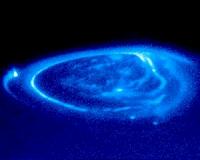 |
Washington (AFP) May 13, 2011 A massive radio telescope in rural West Virginia has begun listening for signs of alien life on 86 possible Earth-like planets, US astronomers said Friday. The giant dish began this week pointing toward each of the 86 planets -- culled from a list of 1,235 possible planets identified by NASA's Kepler space telescope -- and will gather 24 hours of data on each one. "It's not absolutely certain that all of these stars have habitable planetary systems, but they're very good places to look for ET," said University of California at Berkeley graduate student Andrew Siemion. The mission is part of the SETI project, which stands for Search for Extra Terrestrial Intelligence, launched in the mid 1980s. Last month the SETI Institute announced it was shuttering a major part of its efforts -- a 50 million dollar project with 42 telescope dishes known as the Allen Telescope Array (ATA) -- due to a five million dollar budget shortfall. ATA began in 2007 and was operated in partnership by the UC Berkeley Radio Astronomy Lab, which has hosted several generations of such experiments. It was funded by the SETI Institute and the National Science Foundation (NSF). With ATA's dishes in hibernation for now, astronomers hope the powerful Green Bank Telescope, a previous incarnation of which was felled in a windstorm in 1988, will provide targeted information about potential life-supporting planets. "Our search employs the largest fully steerable radio telescope on the planet, and the most sensitive radio telescope in the world capable of undertaking a SETI search of this kind," Siemion told AFP. "We will be looking at a much wider range of frequencies and signal types than has ever been possible before," he added, describing the instrumentation as "at the very cutting edge of radio astronomy technology." The surface of the telescope is 100 by 110 meters and it can record nearly one gigabyte of data per second, Siemion said. The 17 million pound (7.7 million kilogram) telescope became operational in 2000 and is a project of the NSF's National Radio Astronomy Observatory. "We've picked out the planets with nice temperatures -- between zero and 100 degrees Celsius -- because they are a lot more likely to harbor life," said physicist Dan Werthimer. Werthimer heads a three-decade long SETI project in Puerto Rico, home of the world's largest radio telescope, Arecibo. However that project could not observe the same area of the northern sky as the Green Bank telescope, he said. "With Arecibo, we focus on stars like our Sun, hoping that they have planets around them that emit intelligent signals," Werthimer said in a statement. "But we've never had a list of planets like this before." The Green Bank Telescope can scan 300 times the range of frequencies that Arecibo could, meaning that it can collect the same amount of data in one day that Arecibo could in one year. The project will likely take about a year to complete, and will be helped by a team of one million at-home astronomers, known as SETI@home users, who will help process the data on personal computers.
Share This Article With Planet Earth
Related Links Life Beyond Earth Lands Beyond Beyond - extra solar planets - news and science
 Detecting Wandering Worlds That Host Life
Detecting Wandering Worlds That Host LifeMoffett Field CA (SPX) May 13, 2011 Interstellar planets - those without stars to orbit - could serve as havens for life. They are often thought to be nearly invisible, since they are much dimmer than stars and do not have any suns nearby to illuminate them. Now, however, research suggests these worlds might be detected by their auroras. Interstellar planets might either be rogue planets that were originally born around a st ... read more |
|
| The content herein, unless otherwise known to be public domain, are Copyright 1995-2010 - SpaceDaily. AFP and UPI Wire Stories are copyright Agence France-Presse and United Press International. ESA Portal Reports are copyright European Space Agency. All NASA sourced material is public domain. Additional copyrights may apply in whole or part to other bona fide parties. Advertising does not imply endorsement,agreement or approval of any opinions, statements or information provided by SpaceDaily on any Web page published or hosted by SpaceDaily. Privacy Statement |